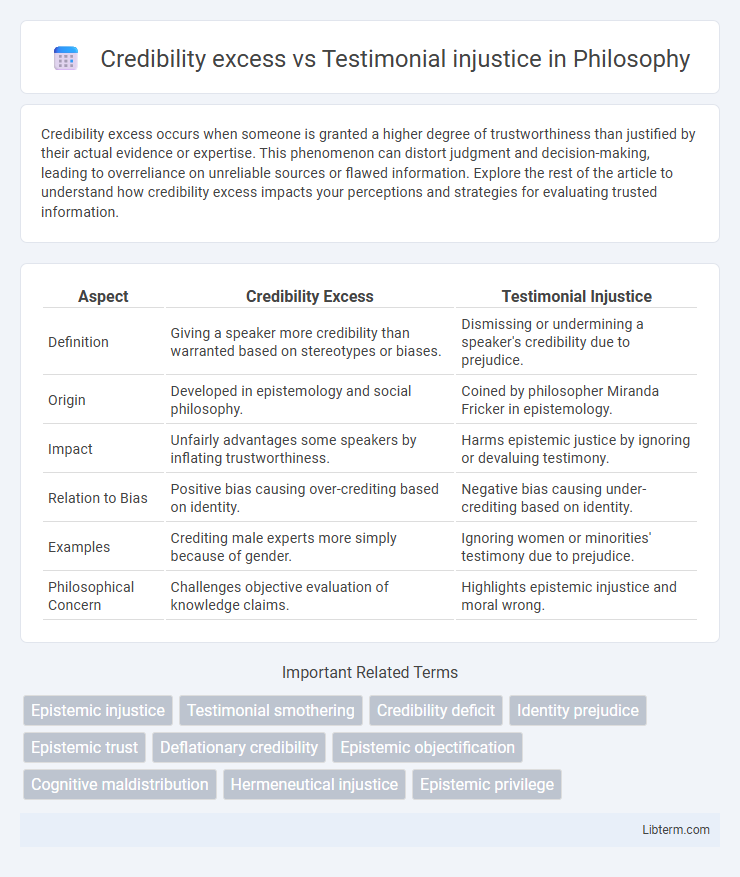Credibility excess occurs when someone is granted a higher degree of trustworthiness than justified by their actual evidence or expertise. This phenomenon can distort judgment and decision-making, leading to overreliance on unreliable sources or flawed information. Explore the rest of the article to understand how credibility excess impacts your perceptions and strategies for evaluating trusted information.
Table of Comparison
| Aspect | Credibility Excess | Testimonial Injustice |
|---|---|---|
| Definition | Giving a speaker more credibility than warranted based on stereotypes or biases. | Dismissing or undermining a speaker's credibility due to prejudice. |
| Origin | Developed in epistemology and social philosophy. | Coined by philosopher Miranda Fricker in epistemology. |
| Impact | Unfairly advantages some speakers by inflating trustworthiness. | Harms epistemic justice by ignoring or devaluing testimony. |
| Relation to Bias | Positive bias causing over-crediting based on identity. | Negative bias causing under-crediting based on identity. |
| Examples | Crediting male experts more simply because of gender. | Ignoring women or minorities' testimony due to prejudice. |
| Philosophical Concern | Challenges objective evaluation of knowledge claims. | Highlights epistemic injustice and moral wrong. |
Understanding Credibility Excess
Credibility excess occurs when an individual is given more trust or credibility than is warranted based on their identity or social position, often leading to skewed perceptions in epistemic exchanges. This phenomenon contrasts with testimonial injustice, where a speaker's credibility is unjustly deflated due to prejudice. Understanding credibility excess reveals how social biases can elevate certain voices unfairly, influencing knowledge dissemination and reinforcing power imbalances in communication.
Defining Testimonial Injustice
Testimonial injustice occurs when a speaker's credibility is unjustly deflated due to prejudice, leading to their knowledge being undervalued or dismissed. It specifically addresses the epistemic harm experienced by marginalized groups whose testimonies are systematically discredited. In contrast, credibility excess involves granting unwarranted credibility, often to privileged individuals, reinforcing epistemic inequalities.
The Dynamics of Social Epistemology
Credibility excess occurs when a speaker is attributed more trustworthiness than warranted, often influenced by social biases, while testimonial injustice arises when a speaker's credibility is unfairly deflated due to prejudice. In social epistemology, these phenomena reveal how power dynamics and social identities shape the distribution of epistemic authority and trust in knowledge exchanges. Understanding these dynamics is crucial for addressing epistemic oppression and promoting equitable testimonial exchanges.
Causes of Credibility Imbalances
Credibility excess occurs when an individual is attributed more credibility than warranted, often influenced by stereotypes or social privilege, while testimonial injustice arises from unjustified credibility deflation due to prejudice or bias. Both credibility imbalances stem from systemic factors such as power dynamics, cultural assumptions, and implicit biases that distort the evaluation of a person's testimony. Understanding these causes highlights the crucial need to address structural inequities and promote fair epistemic practices in interpersonal communication.
Effects of Credibility Excess in Discourse
Credibility excess leads to disproportionate trust placed in certain speakers, amplifying their perspectives while marginalizing others in discourse, thereby skewing the exchange of knowledge. This imbalance can reinforce existing social hierarchies by privileging dominant voices and undermining the epistemic contributions of less recognized individuals. Consequently, the effects of credibility excess distort communicative equality and hinder fair and inclusive knowledge-sharing practices.
Impact of Testimonial Injustice on Marginalized Voices
Testimonial injustice occurs when marginalized voices are unfairly discredited, leading to a reduction in their perceived credibility and silencing important perspectives. This injustice undermines social trust and obstructs access to resources and justice for marginalized groups. In contrast, credibility excess involves giving undue trust, which can perpetuate systemic biases by amplifying dominant voices over marginalized ones.
Mechanisms of Bias in Testimonial Exchanges
Credibility excess occurs when a speaker is attributed more credibility than warranted, often due to positive stereotypes, while testimonial injustice involves unfairly deflating a speaker's credibility based on negative biases tied to social identity. Both mechanisms stem from epistemic injustice, where prejudicial stereotyping affects the reception of testimony, distorting the truth assessment process. In testimonial exchanges, these biases disrupt equitable knowledge transmission by either overvaluing or undervaluing a speaker's epistemic contributions.
Addressing and Mitigating Credibility Inequities
Addressing and mitigating credibility inequities requires recognizing and challenging credibility excess, where individuals are unjustly attributed higher credibility due to social biases, alongside testimonial injustice, which denies credibility based on prejudice. Implementing structured protocols for evaluating testimonies and fostering awareness about implicit biases can help balance credibility assessments across diverse social groups. Training institutions and organizations to promote equitable testimonial practices ensures a fairer distribution of epistemic trust.
Case Studies: Real-World Examples
Credibility excess occurs when a person's testimony is given more weight than warranted, often benefiting those from dominant groups, while testimonial injustice involves unfairly discrediting someone's word, typically harming marginalized individuals. In a 2016 case study of workplace harassment, a female employee's claims were dismissed despite substantial evidence, illustrating testimonial injustice rooted in gender bias. Conversely, a 2018 corporate board scenario revealed credibility excess where a senior male executive's unverified statements were accepted without scrutiny, skewing decision-making processes.
Toward Epistemic Justice in Communication
Credibility excess occurs when a speaker is granted unwarranted trust based on biases favoring social identity, while testimonial injustice involves unfairly deflating a speaker's credibility due to prejudice. Both phenomena undermine epistemic justice by distorting the fair distribution of knowledge and recognition in communication. Addressing these issues is crucial for fostering equitable epistemic exchanges and promoting inclusive dialogue across diverse social groups.
Credibility excess Infographic

 libterm.com
libterm.com